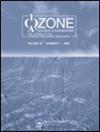Surface Dielectric Barrier Discharge in a Cylindrical Configuration – Effect of Airflow Orientation to the Microdischarges
IF 1.4
4区 环境科学与生态学
Q3 ENGINEERING, ENVIRONMENTAL
引用次数: 0
Abstract
ABSTRACT This paper is devoted to studying the effect of airflow orientation on the microdischarges of the surface dielectric barrier discharge in cylindrical configuration through varying air input into the discharge chamber, the number of input nozzles, and the geometry of the active electrode. The air is supplied into the discharge chamber tangentially, radially, or axially through one or four input nozzles. Air input into the discharge chamber and the number of input nozzles determine the airflow regime. We used two active electrode geometries that are the axial strips or azimuthal rings. The change of active electrode geometry from rings to strips affects the orientation of microdischarges with respect to the airflow. For the discharge, the variation of air inputs and the number of input nozzles influences the flow regime in the discharge chamber, which, together with the active electrode geometry, affects the temperature field distribution in the chamber. These factors play an important role in plasmachemical processes leading to the discharge generation of various species, such as ozone. It is found that, for the maximum effect of airflow on discharge ozone generation, the streamlines should be uniformly distributed in the discharge chamber and predominantly oriented perpendicular to the majority of microdischarges.圆柱形表面介质阻挡放电——气流方向对微放电的影响
本文通过改变放电腔的空气输入量、输入喷嘴的数量和活性电极的几何形状,研究了气流方向对圆柱形表面介质阻挡放电微放电的影响。空气通过一个或四个输入喷嘴切向,径向或轴向供应到排出室。进入排气室的空气和输入喷嘴的数量决定了气流的状态。我们使用了两种有源电极几何形状,即轴带或方位环。主动电极的几何形状从环形到条状的变化影响了微放电相对于气流的方向。在放电过程中,空气输入量和输入喷嘴数量的变化会影响放电室内的流态,而流态与活动电极的几何形状一起影响放电室内的温度场分布。这些因素在等离子体化学过程中起着重要作用,导致各种物质(如臭氧)的排放产生。研究发现,为了使气流对放电臭氧产生的影响达到最大,流线应均匀分布在放电室内,并且主要垂直于大多数微放电方向。
本文章由计算机程序翻译,如有差异,请以英文原文为准。
求助全文
约1分钟内获得全文
求助全文
来源期刊

Ozone: Science & Engineering
环境科学-工程:环境
CiteScore
5.90
自引率
11.10%
发文量
40
审稿时长
2 months
期刊介绍:
The only journal in the world that focuses on the technologies of ozone and related oxidation technologies, Ozone: Science and Engineering brings you quality original research, review papers, research notes, and case histories in each issue. Get the most up-to date results of basic, applied, and engineered research including:
-Ozone generation and contacting-
Treatment of drinking water-
Analysis of ozone in gases and liquids-
Treatment of wastewater and hazardous waste-
Advanced oxidation processes-
Treatment of emerging contaminants-
Agri-Food applications-
Process control of ozone systems-
New applications for ozone (e.g. laundry applications, semiconductor applications)-
Chemical synthesis.
All submitted manuscripts are subject to initial appraisal by the Editor, and, if found suitable for further consideration, to peer review by independent, anonymous expert referees.
 求助内容:
求助内容: 应助结果提醒方式:
应助结果提醒方式:


